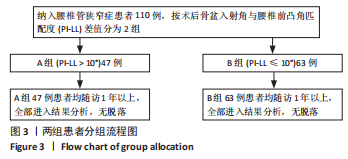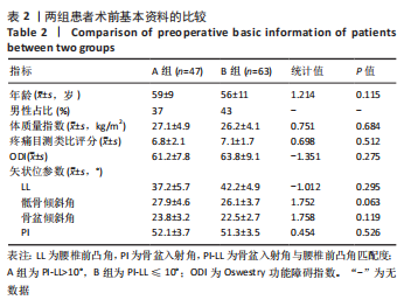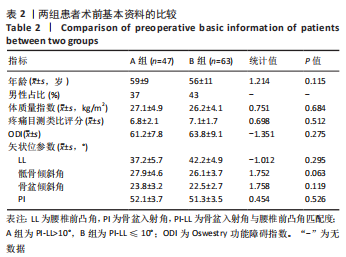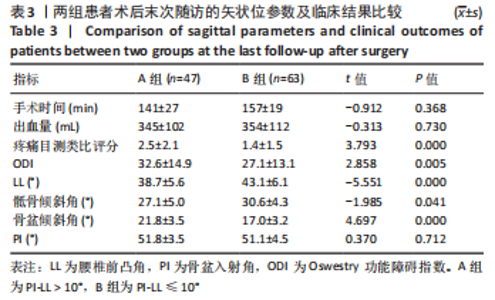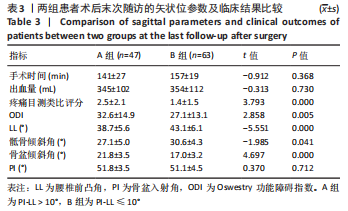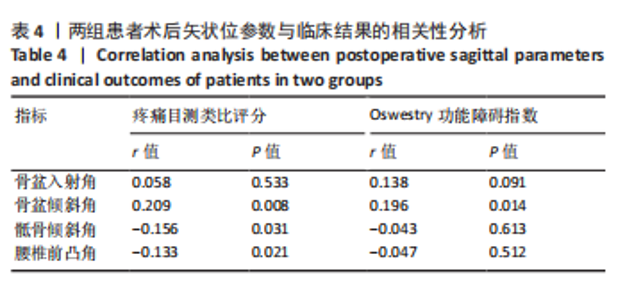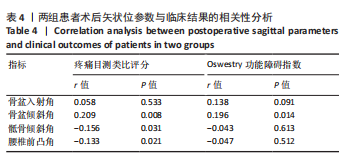Chinese Journal of Tissue Engineering Research ›› 2024, Vol. 28 ›› Issue (24): 3778-3782.doi: 10.12307/2024.618
Previous Articles Next Articles
Correlation between sagittal alignment and clinical symptom improvement after lumbar fusion
Fang Zhao, Qiao Pan, Xu Tiantong
- Department of Spinal Surgery, Tianjin Union Medical Center, Tianjin 300121, China
-
Received:2023-06-19Accepted:2023-08-04Online:2024-08-28Published:2023-11-20 -
Contact:Xu Tiantong, Master, Chief physician, Department of Spinal Surgery, Tianjin Union Medical Center, Tianjin 300121, China -
About author:Fang Zhao, Master, Attending physician, Department of Spinal Surgery, Tianjin Union Medical Center, Tianjin 300121, China -
Supported by:Construction Project of Key Medical Disciplines (Specialties) in Tianjin, No. TJYXZDXK-064B (to XTT)
CLC Number:
Cite this article
Fang Zhao, Qiao Pan, Xu Tiantong. Correlation between sagittal alignment and clinical symptom improvement after lumbar fusion[J]. Chinese Journal of Tissue Engineering Research, 2024, 28(24): 3778-3782.
share this article
Add to citation manager EndNote|Reference Manager|ProCite|BibTeX|RefWorks
| [1] HE S, ZHANG Y, JI W, et al. Analysis of Spinopelvic Sagittal Balance and Persistent Low Back Pain (PLBP) for Degenerative Spondylolisthesis (DS) following Posterior Lumbar Interbody Fusion (PLIF). Pain Res Manag. 2020; 2020:597137. [2] UYSAL M, OZALAY M, DERINCEK A, et al. Effect of PLIF and TLIF on sagittal spinopelvic balance of patients with degenerative spondylolisthesis. Acta Orthop Traumatol Turc. 2018;52(4):272-276. [3] MOHANTY S, BARCHICK S, KADIYALA M, et al. Should patients with lumbar stenosis and grade I spondylolisthesis be treated differently based on spinopelvic alignment? A retrospective, two-year, propensity matched, comparison of patient-reported outcome measures and clinical outcomes from multiple sites within a single health system. Spine J. 2022;23:92-104. [4] LIOW MHL, GOH GS, CHUA JL, et al. Sagittally Balanced Degenerative Spondylolisthesis Patients With Increased Sacral Slope and Greater Lumbar Lordosis Experience Less Back Pain After Short-Segment Lumbar Fusion Surgery. Clin Spine Surg. 2020;33(5):E231-E235. [5] SCHWAB F, PATEL A, UNGAR B, et al. Adult spinal deformity-postoperative standing imbalance: how much can you tolerate? An overview of key parameters in assessing alignment and planning corrective surgery. Spine (Phila Pa 1976). 2010;35(25):2224-2231. [6] ISHIHARA M, TANIGUCHI S, ADACHI T, et al. Conditions for Achieving Postoperative Pelvic Incidence-Lumbar Lordosis < 10° in Circumferential Minimally Invasive Surgery for Adult Spinal Deformity. J Clin Med. 2022; 11(6):1586. [7] KATZ JN, ZIMMERMAN ZE, MASS H, et al. Diagnosis and Management of Lumbar Spinal Stenosis: A Review. JAMA. 2022;327(17):1688-1699. [8] SHAFSHAK TS, ELNEMR R. The Visual Analogue Scale Versus Numerical Rating Scale in Measuring Pain Severity and Predicting Disability in Low Back Pain. J Clin Rheumatol. 2021;27(7):282-285. [9] MCCORMACK HM, HORNE DJ, SHEATHER S.Clinical applications of visual analogue scales: a critical review. Psychol Med. 1988;18(4):1007-1019. [10] CHUN SW, LIM CY, KIM K, et al. The relationships between low back pain and lumbar lordosis: a systematic review and meta-analysis. Spine J. 2017; 17(8):1180-1191. [11] TAKAHASHI Y, OKUDA S, NAGAMOTO Y, et al. Effect of segmental lordosis on the clinical outcomes of 2-level posterior lumbar interbody fusion for 2-level degenerative lumbar spondylolisthesis. J Neurosurg Spine. 2019:1-6. doi: 10.3171/2019.4.SPINE181463. [12] LE HUEC JC, FAUNDEZ A, DOMINGUEZ D, et al. Evidence showing the relationship between sagittal balance and clinical outcomes in surgical treatment of degenerative spinal diseases: a literature review. Int Orthop. 2015;39(1):87-95. [13] HSU HT, YANG SS, CHEN TY. The Correlation Between Restoration of Lumbar Lordosis and Surgical Outcome in the Treatment of Low-grade Lumbar Degenerative Spondylolisthesis With Spinal Fusion. Clin Spine Surg. 2016; 29(1):E16-E20. [14] BREDOW J, MEYER C, OIKONOMIDIS S, et al. Long-term Radiological and Clinical Outcome after Lumbar Spinal Fusion Surgery in Patients with Degenerative Spondylolisthesis: A Prospective 6-Year Follow-up Study. Orthop Surg. 2022;14(8):1607-1614. [15] BOULAY C, TARDIEU C, HECQUET J, et al. Sagittal alignment of spine and pelvis regulated by pelvic incidence: standard values and prediction of lordosis. Eur Spine J. 2006;15:415-422. [16] CHUANG HC, TSENG YH, CHEN Y, et al. Assessment of sagittal spinopelvic parameters in a Taiwanese population with spondylolysis by the EOS imaging system: a retrospective radiological analysis. BMC Musculoskelet Disord. 2021;22:553. [17] HASEGAWA K, OKAMOTO M, HATSUSHIKANO S, et al. Normative values of spino-pelvic sagittal alignment, balance, age, and health-related quality of life in a cohort of healthy adult subjects. Eur Spine J. 2016;25(11):3675-3686 [18] HE S, ZHANG Y, JI W, et al. Analysis of Spinopelvic Sagittal Balance and Persistent Low Back Pain (PLBP) for Degenerative Spondylolisthesis (DS) following Posterior Lumbar Interbody Fusion (PLIF). Pain Res Manag. 2020; 2020:5971937 [19] LE HUEC JC, FAUNDEZ A, DOMINGUEZ D, et al. Evidence showing the relationship between sagittal balance and clinical outcomes in surgical treatment of degenerative spinal diseases: a literature review. Int Orthop. 2015;39:87-95. [20] PRATALI RR, BATTISTI R, OLIVEIRA CEAS, et al. Correlation between the Severity of the Lumbar Degenerative Disease and Sagittal Spinopelvic Alignment. Rev Bras Ortop (Sao Paulo). 2022;57(1):41-46. [21] PRATALI RR, BATTISTI R, OLIVEIRA CEAS, et al. Correlation between the Severity of the Lumbar Degenerative Disease and Sagittal Spinopelvic Alignment. Rev Bras Ortop (Sao Paulo). 2022;57(1):41-46. [22] KIEFFER WKM, DON A, FIELD A, et al. Lordosis loss in degenerative spinal conditions. Spine Deform. 2022;10(6):1407-1414. [23] LEVEQUE JA, DROLET CE, NEMANI V, et al. The Impact of Surgical Approach on Sagittal Plane Alignment in Patients Undergoing One- or Two- Level Fusions for Degenerative Pathology: A Multicenter Radiographic Evaluation 6 Months Following Surgery. World Neurosurg. 2022;164:e311-e317. [24] ALIZADEH R, SHARIFZADEH SR. Pathogenesis, etiology and treatment of failed back surgery syndrome. Neurochirurgie. 2022;68(4):426-431. [25] RIGOARD P, BLOND S, DAVID R, et al. Pathophysiological characterisation of back pain generators in failed back surgery syndrome (part B). Neurochirurgie. 2015;61 Suppl 1:S35-S44 [26] BREDOW J, MEYER C, OIKONOMIDIS S, et al. Long-term Radiological and Clinical Outcome after Lumbar Spinal Fusion Surgery in Patients with Degenerative Spondylolisthesis: A Prospective 6-Year Follow-up Study. Orthop Surg. 2022;14(8):1607-1614. [27] MOHANTY S, BARCHICK S, KADIYALA M, et al. Should patients with lumbar stenosis and grade I spondylolisthesis be treated differently based on spinopelvic alignment? A retrospective, two-year, propensity matched, comparison of patient-reported outcome measures and clinical outcomes from multiple sites within a single health system. Spine J. 2023;23(1):92-104. [28] COLLINET A, NTILIKINA Y, ROMANI A, et al. Psychopathological profile and sagittal alignment in low-back pain. Orthop Traumatol Surg Res. 2023; 109(2):103474. [29] CHUN SW, LIM CY, KIM K, et al. The relationships between low back pain and lumbar lordosis: a systematic review and meta-analysis. Spine J. 2017; 17(8):1180-1191. [30] 李玉乔,孙天威,马彬. 腰椎滑脱亚型间影像学参数与生活质量评分的对照分析[J]. 中国组织工程研究,2022,26(6):987-992. |
| [1] | Liu Jiang, Zhang Hanshuo, Ding Yiwei, Jiang Qiang, Li Tusheng, Huang Jie, Yang Guangnan, Ding Yu. Finite element analysis of interspinous fixation-assisted endoscopic interbody fusion in treatment of severe lumbar spinal stenosis#br# [J]. Chinese Journal of Tissue Engineering Research, 2024, 28(24): 3789-3795. |
| [2] | Zhang Jinghe, Dou Yongfeng, Xu Shidong, Xing Jianqiang, Liu Dong, Tian Lin, Dai Guohua. Effect of finite element simulation of bilateral lumbar spinal canal decompression under single-channel splintered endoscope on lumbar biomechanics [J]. Chinese Journal of Tissue Engineering Research, 2024, 28(12): 1849-1854. |
| [3] | Wang Jianye, Liu Xin, Tian Lin, Sun Ning, Li Yuefei, Bi Jingwei, Liu Changzhen, Sun Zhaozhong . Measuring the position relation between nerve tissue and bony structure in lumbar spinal canal decompression area by constructing a three-dimensional model of the lumbar spine [J]. Chinese Journal of Tissue Engineering Research, 2023, 27(4): 539-546. |
| [4] | Liu Ziwen, Yang Yuming, Xie Hongru, Zhang Zepei, Xu Haoxiang, Miao Jun. Relationship between the degeneration of paraspinal muscle and sagittal alignment [J]. Chinese Journal of Tissue Engineering Research, 2023, 27(36): 5891-5897. |
| [5] | Wang Mengshu, Zhang Yu, Zheng Zhouhang, Chen Long, You Dongchun, Guo Weifeng, Hu Fei, Chen Huan, Liu Xingming, Wu Ronghai, Zhang Yin. Differential protein expression analysis of hypertrophic and normal ligamentum flavum in patients with lumbar spinal stenosis with Qi deficiency and blood stasis [J]. Chinese Journal of Tissue Engineering Research, 2023, 27(35): 5589-5595. |
| [6] | An Hepeng, Liu Zhenteng, Li Lixin, Xu Yafang, Fan Guofeng. Effects of brain-derived neurotrophic factor on neuronal activity, pain, and related cytokines in rats with lumbar spinal stenosis [J]. Chinese Journal of Tissue Engineering Research, 2023, 27(26): 4120-4125. |
| [7] | Xiao Shipeng, Guo Chen, Li Shichun, Li Qinliang, Xu Yong, Xu Shuai. Analysis and reconstruction of sagittal lumbo-pelvic parameters in the elderly with lumbar spinal stenosis [J]. Chinese Journal of Tissue Engineering Research, 2023, 27(18): 2903-2909. |
| [8] | Zhang Hanshuo, Ding Yu, Jiang Qiang, Lu Zhengcao, Lian Shilin, Li Tusheng. Biomechanical stability and finite element analysis of endoscopic LOVE decompression technique and endoscopic unilateral laminotomy for bilateral decompression technique for lumbar spinal stenosis [J]. Chinese Journal of Tissue Engineering Research, 2023, 27(13): 1981-1986. |
| [9] | Bao Xianguo, Gao Zengxin, Wu Zhanpo, Chen Youmin, Cheng Qinghua, Lu Haitao, Guo Changzheng, Xu Shuai. Correlation between lumbar posterior muscle and local kyphosis in patients with degenerative thoracolumbar kyphosis [J]. Chinese Journal of Tissue Engineering Research, 2022, 26(9): 1418-1423. |
| [10] | Li Yuqiao, Sun Tianwei, Ma Bin, Zhou Zhaohong, Dong Runbei, Wu Haiyang. A comparative study of imaging parameters and quality of life scores between subtypes of lumbar spondylolisthesis [J]. Chinese Journal of Tissue Engineering Research, 2022, 26(6): 943-948. |
| [11] | Xu Wei, Li Zhifei, Wan Tong, Yu Weibo, Zhang Yisheng, Zhou Jinyan, Bu Xianzhong, Zhong Yuanming. Application of height adjustable titanium fusion cage in endoscopic lumbar fusion [J]. Chinese Journal of Tissue Engineering Research, 2022, 26(33): 5335-5341. |
| [12] | Pan Xian, Liang Simin, Liu Bingxia, Song Tianzeng, Ma He, Wu Peng, Ge Zhaohui. Correlation between pelvic incidence-lumbar lordosis and clinical outcome in patients with degenerative lumbar scoliosis [J]. Chinese Journal of Tissue Engineering Research, 2022, 26(33): 5370-5375. |
| [13] | Yao Rubin, Wang Shiyong, Yang Kaishun. Minimally invasive transforaminal lumbar interbody fusion for treatment of single-segment lumbar spinal stenosis improves lumbar-pelvic balance [J]. Chinese Journal of Tissue Engineering Research, 2021, 25(9): 1387-1392. |
| [14] | Tian Yang, Tang Chao, Liao Yehui, Tang Qiang, Ma Fei, Zhong Dejun. Consistency and repeatability of CT and MRI in measurement of spinal canal area in patients with lumbar spinal stenosis [J]. Chinese Journal of Tissue Engineering Research, 2021, 25(24): 3882-3887. |
| [15] | Zhang Mingyan, Liu Xiangyang, Chang Lei, Chen Jing, Shen Xiongjie, Liu Bin, Peng Shuai, Zhang Chao, Wu Huanyu, Zhu Feng, Mou Haipin . Relationship between the intraoperative endplate injury and cage retropulsion after lumbar interbody fusion [J]. Chinese Journal of Tissue Engineering Research, 2021, 25(18): 2856-2862. |
| Viewed | ||||||
|
Full text |
|
|||||
|
Abstract |
|
|||||

